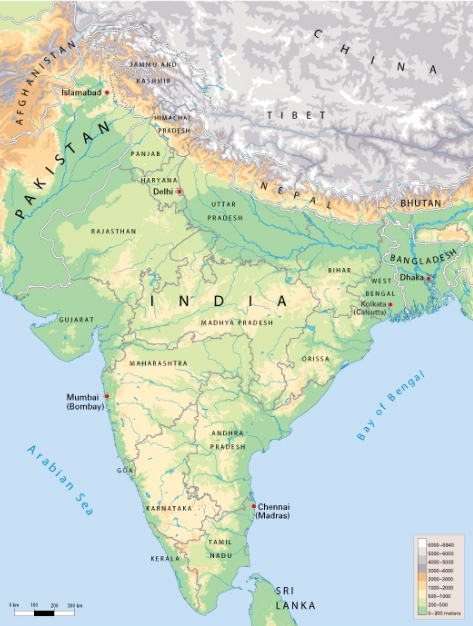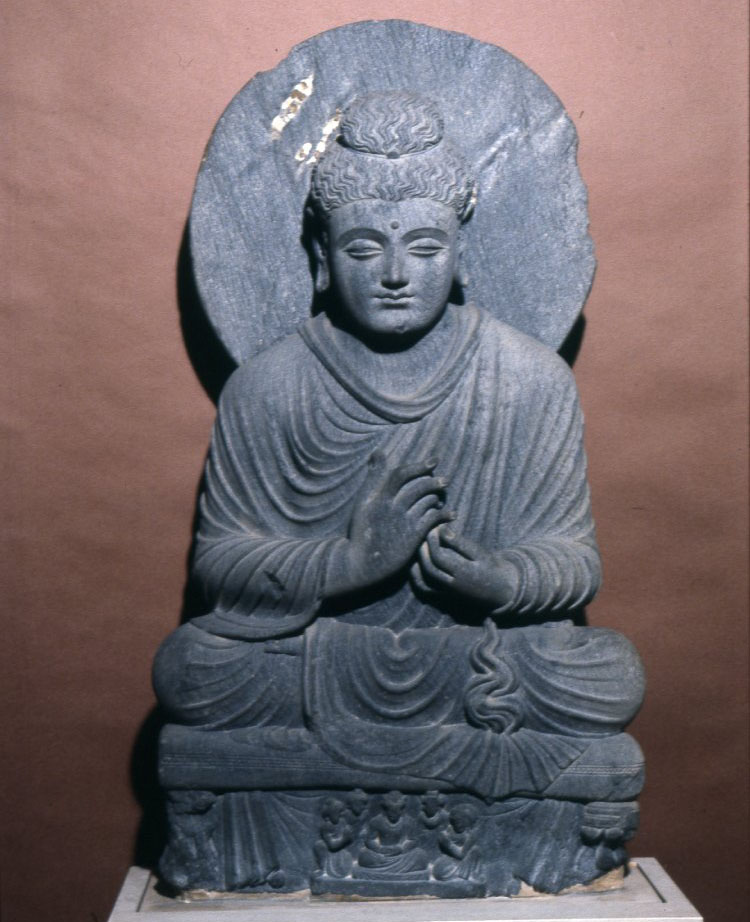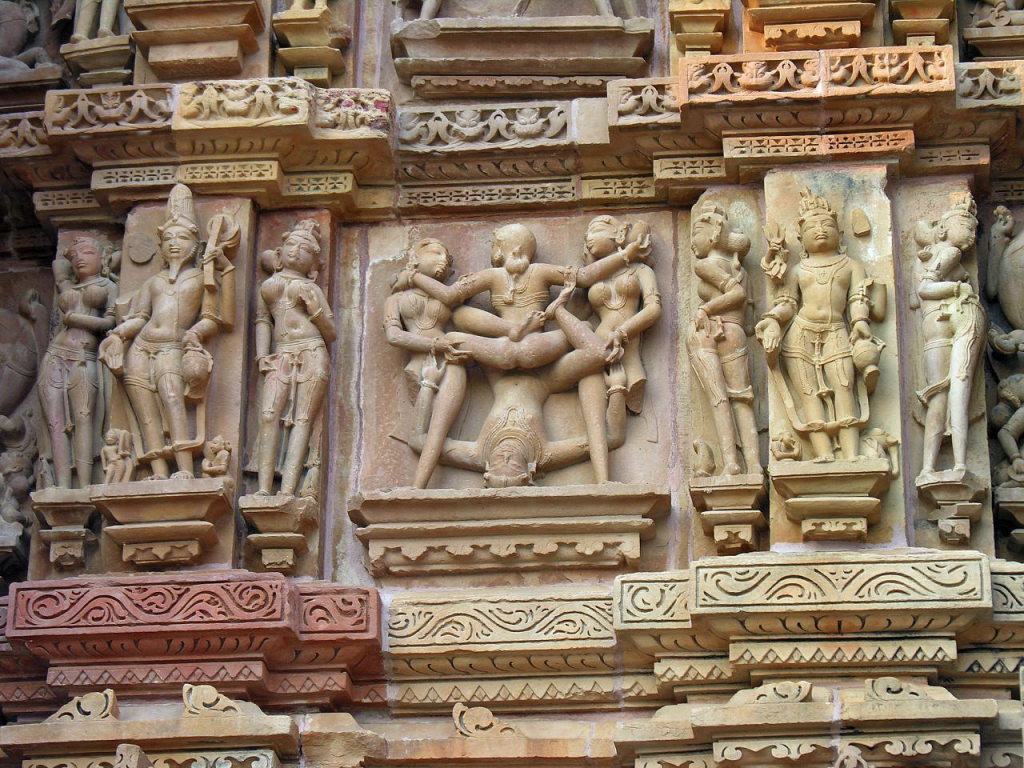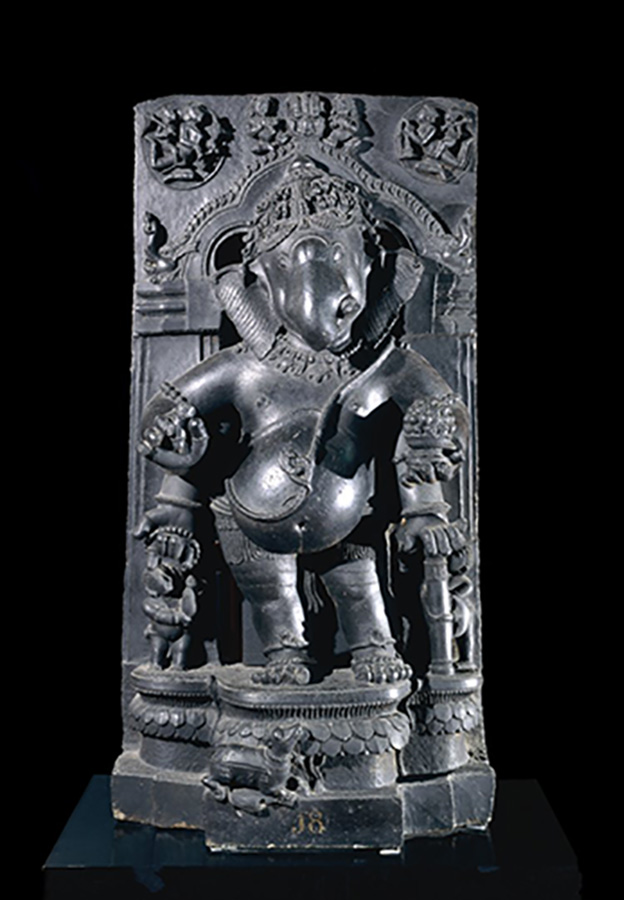Chapter 12.7: South Asia
What are often thought of as “Indian” art and culture spread not only throughout the modern nation of India but also through Pakistan and Bangladesh. This huge area was never politically unified except under British colonial rule (1858–1947). Earlier, various kingdoms and principalities controlled large or small areas, and occasionally a conqueror created a vast empire.
The Indian cultural area was separated from other cultural areas by formidable natural barriers. Oceans surrounded southern India. To the north and northeast, the Himalayas and other mountain ranges, as well as great deserts, made overland travel to and from China exceedingly arduous. The northwest, too, was blocked by mountains and deserts, but these were less difficult to cross, so invaders typically entered from this direction. In spite of these barriers, South Asia engaged in contact with other cultures in a variety of ways. Traders and pilgrims could, with effort, cross the deserts and mountain passes. The ocean prevented the large-scale movement of populations but served as a highway for shipborne travel and trade.
South Asia is the seat of many of the world’s great religious traditions, most notably Buddhism, Hinduism, and Jainism.


Buddhism was established in the fifth century B.C.E. by the Buddha or “enlightened one.” However, it was not until the third century B.C.E. that Buddhism enjoyed royal patronage under the Mauryan kings—notably Ashoka—and spread to all parts of the subcontinent.
Buddhism continued to flourish in subsequent centuries, reaching Southeast Asia in the fifth century C.E. and Tibet in the seventh. Mahavira—the “great hero” —was a contemporary of the Buddha and founder of the Jain faith. This religion, with its emphasis on harsh asceticism, has been less popular than Buddhism and did not spread beyond continental South Asia.
Nonetheless, it has survived to the present and, through the centuries, has enjoyed strong support from the merchant and banking classes. The artistic heritage of Jainism is thus especially rich. Hinduism has very ancient roots but began to assume its mature form only in the fourth century C.E. The most characteristic features of mature Hinduism are the worship of divine images and the construction of temples to house these images. Hinduism has a vast pantheon of male and female deities but preeminent among them are Shiva and Vishnu. Although indigenous religions dominate Indian history, it is important to note that Christianity was established in India in the first century when the apostle St. Thomas travelled east. Islam, too, became a significant force in South Asia from the early eighth century.
India is one of the largest countries in the world, with over 1 billion citizens. But what makes India truly unique is that it is home to a great assortment of religions and philosophies. The most popular religions include Christianity, Islam, Hinduism, and Jainism. The people also take a great interest in several philosophies such as Yoga Sutras, the Bhakti movement, and Buddhism. This makes India one of the most culturally diverse countries in the world.
Having such an assortment of religions and philosophies, has produced a great variety of artistic creations over the generations of India’s history. One of the greatest contributor’s to India’s art foundation are the Hindus. Hinduism is a greatly complex religion that takes no basis in a single prophet or spokesperson. The foundation of the religion is upon the four goals of life: dharma (righteous living), artha (wealth), kama (love) and, moksha (spiritual salvation). This foundation has inspired the artwork created over time. Majority of Hindu art is in the form of sculptures. These sculptures feature the holy figures of the religion, such as Krishna and Ganesha. Their most common mediums are terracotta and stone. One of the most common symbols found in Hindu art is the extra limbs found in the sculptures. These extra limbs represent how powerful the god is as they are capable of completing multiple tasks at once. The second major symbol found in Hindu art is the lotus flower. The lotus flower in Hinduism represents purity, beauty, and transcendence.
Hindu art and Buddhist art are very similar in the culture that they represent. The major factor that separates the two is Buddha. Buddha was the spiritual teacher who founded Buddhism. His teachings surround the idea of rejecting luxuries and wants and focusing on solely achieving nirvana, release from earthly existence. He became the feature for the majority of Buddhist art pieces, especially in sculptures. Majority of Buddhist sculptures are created using bronze as the medium, although some others feature sandstone or other stones. Some of the greatest Buddhist artwork is found in stupas – large hemispherical mounds. These stupas are considered monuments of Buddhism. This is very similar to Hindu art, which is also featured in holy temples across India. Just like Hindus, Buddhists take great lengths to preserve the holy relics of their great philosopher. Temporary Buddhist art is extremely rare as Buddhism has great difficulty competing with Hinduism and Islam in India. Whether it’s a statue of Krishna or Buddha, India is home to some of the greatest artwork in the world. These great sculptures and works of art reside in countless temples and museums, even beyond the borders of India, and will reign forever.

Videos
Beliefs Made Visible: Hindu Art in South Asia (29:29)
Beliefs Made Visible: Buddhist Art in South Asia (20:24)
Ganesha Jayanti, Lord of Beginnings
The remover of obstacles
The elephant-headed Ganesha is renowned throughout India as the Lord of Beginnings, and both the placer and the remover of obstacles. It is for this reason that he is worshipped before any new venture is begun when his benediction is essential. Temporary statues are created every year for the Ganeshchaturthi festival in Mumbai, and are placed in public or domestic shrines before being immersed in water at the end of the celebrations.


Media Attributions
- Figure 1. Enlarge the map at AsianArt.org (Image source: Courtesy of the Asian Art Museum; Diwali Festival and Threshold Art, Diwali Festival slides)
- Figure 2. Seated Buddha from Gandhara, c. 2nd – 3rd century C.E., 95 x 53 x 24 cm, Pakistan (Image source: © Trustees of the British Museum. Used with permission, for education only)
- Figure 3. External wall of the Kandariya Mahadeva Temple in Central India (Image source: Wikimedia Commons) is licensed under a CC BY-SA (Attribution ShareAlike) license
- Figure 4. Figure of Gaṇeśa, 13th century, schist, 119 cm high. Typically corpulent and holding a bowl of sweets, the god is shown standing on a lotus pedestal at the base of which crouches his rat “vahana.” His anklets are of snakes, as is the sacred thread wound across his chest. The arch within which he stands is of a standard Indian decorative type with a lion mask (kirttimukha) at the top, and aquatic monsters (makaras) at each end (Image source: © Trustees of the British Museum. Used with permission, for education use only)
- Figure 5. Painting of Gaṇeśa mounted on his rat. Gouache on paper. Inscribed. ca. 1790-1810 (Image source: © Trustees of the British Museum. Used with permission, for education use only)
Candela Citations
- South Asian religions, an introduction. Authored by: Trustees of the British Museum. Provided by: Khan Academy. Retrieved from: https://www.khanacademy.org/humanities/art-asia/south-asia/south-asia-intro/a/south-asian-religions-an-introduction. License: CC BY-NC-SA: Attribution-NonCommercial-ShareAlike
- Beliefs made visible: Hindu art in South Asia. Authored by: Asian Art Museum. Provided by: Smarthistory. Retrieved from: https://smarthistory.org/beliefs-made-visible-hindu-art-in-south-asia/. License: CC BY-NC-SA: Attribution-NonCommercial-ShareAlike
- Beliefs made visible: Buddhist art in South Asia. Authored by: Asian Art Museum. Provided by: Smarthistory. Retrieved from: https://smarthistory.org/beliefs-made-visible-buddhist-art-in-south-asia-3/. License: CC BY-NC-SA: Attribution-NonCommercial-ShareAlike

